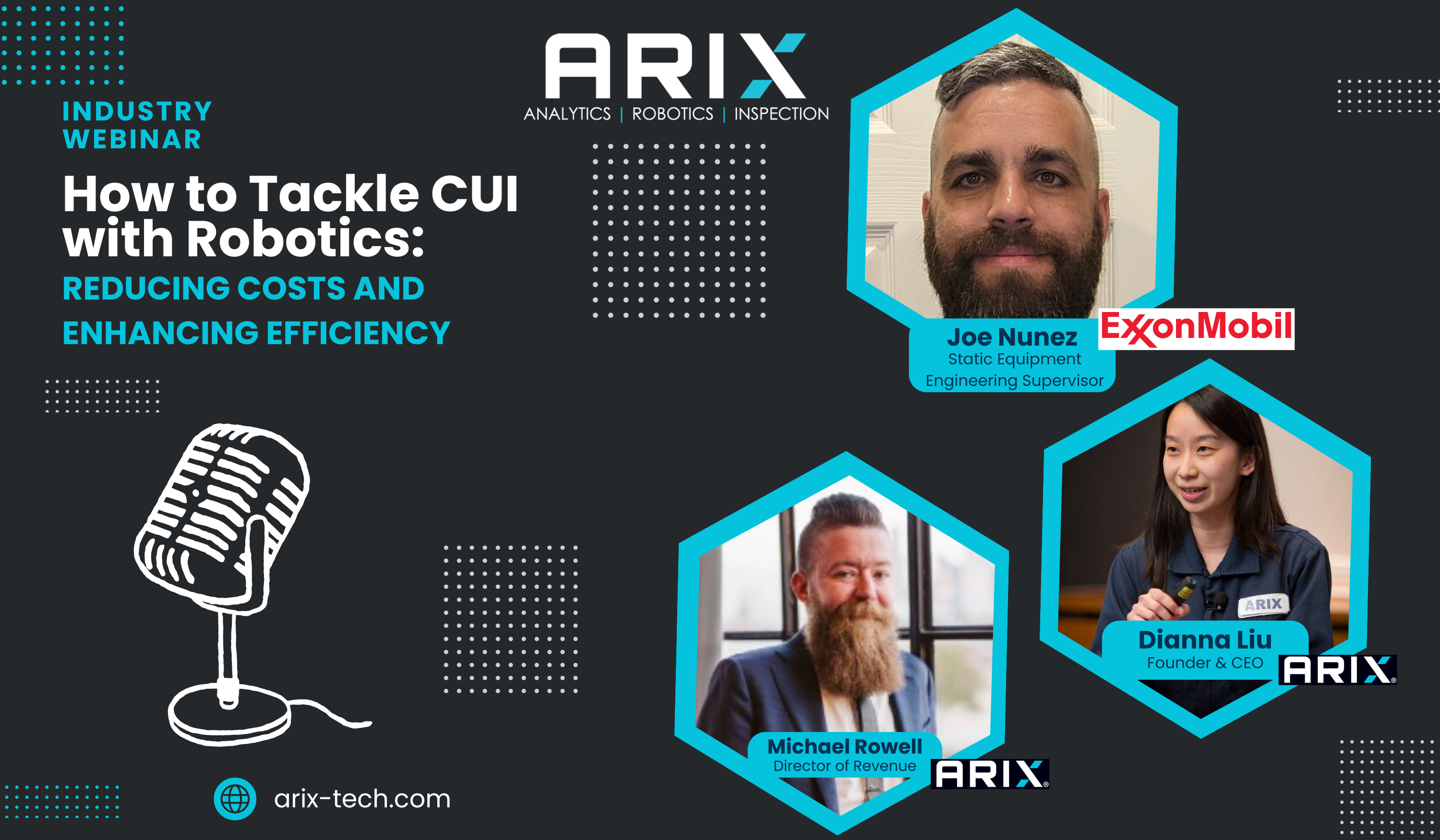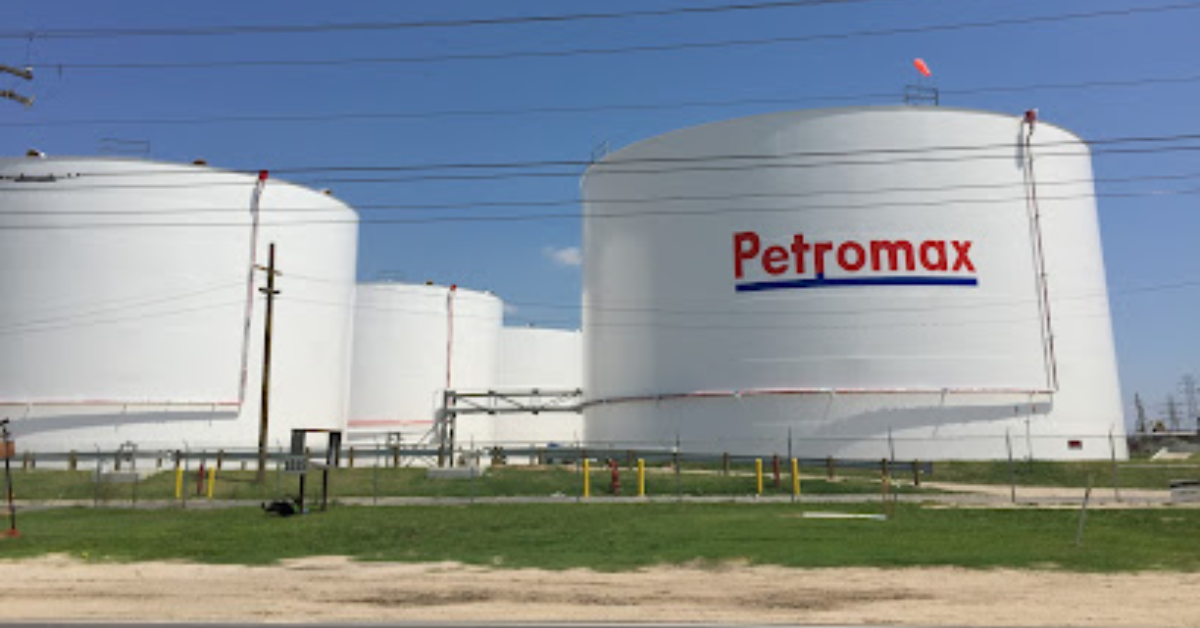Videos, Articles
How to Tackle CUI with Robotics: Reducing Costs & Enhancing Efficiency

In a world where industrial efficiency and safety are paramount, inspection technologies are advancing at lightning speed. One area of particular concern for refineries is corrosion, especially Corrosion Under Insulation (CUI), which presents significant challenges in asset management.
Recently, ARIX Technologies hosted a webinar that explored how robotic solutions, combined with advanced inspection methods like Pulsed Eddy Current (PEC), are revolutionizing the way refineries approach corrosion detection. In this webinar, industry experts Joe Nunez from ExxonMobil and Diana Liu, CEO of ARIX Technologies, discussed the role of robotics in transforming traditional inspection techniques. Let’s dive into some key takeaways.
WATCH THE FULL WEBINAR HERE
The True Cost of Corrosion
Corrosion is a pervasive issue in the petrochemical industry, affecting facilities worldwide. Joe Nunez explained how corrosion impacts not only the infrastructure but also the operational and financial aspects of refineries. The challenge lies in identifying which assets are at risk without having the luxury of an unlimited budget or the ability to inspect every inch of equipment. This is where risk-based inspection (RBI) methodologies play a crucial role, helping prioritize inspection efforts.
The Challenge of Corrosion Under Insulation (CUI)
CUI is one of the most troublesome forms of corrosion because it hides beneath insulation, making it difficult to detect until it’s too late. As Diana Liu noted, the unseen nature of CUI creates significant risk. Refinery operators can’t just strip away insulation from every pipe to inspect for corrosion—this would be prohibitively expensive and time-consuming. Instead, they rely on selective inspection techniques, which can still leave gaps in coverage.
Enter Robotics and PEC
To combat these challenges, ARIX Technologies has developed a robotic solution that automates the inspection process while enhancing safety and efficiency. By integrating PEC technology, their robots are able to detect corrosion beneath insulation without the need for stripping the material away. This allows for a more comprehensive, yet targeted, inspection of critical areas in far less time.
Diana Liu likened the process to using a metal detector to find a lost wedding ring in a field. Instead of digging up the entire field, you sweep the metal detector across the area, only digging when the detector beeps. Similarly, robots equipped with PEC can identify problem areas that require deeper inspection, saving time and reducing costs.
PEC offers several advantages:
- Non-invasive inspection: It can detect corrosion through various coverings without needing to strip insulation.
- High accuracy: Advanced analysis tools provide precise assessments of remaining wall thickness.
- Versatility: Applicable in various industries, including oil and gas, power generation, and marine environments.
The Benefits of Robotic Inspections
Joe Nunez shared his experience with implementing robotic solutions at ExxonMobil and highlighted several key advantages:
- Increased Efficiency: Robots can inspect large areas of piping more quickly and thoroughly than manual inspections.
- Improved Safety: Inspectors no longer need to access dangerous or difficult-to-reach areas, as robots can handle those tasks.
- Cost Savings: By using robotics, refineries can reduce the time and expense associated with traditional inspection methods while still obtaining comprehensive data.
Managing Data Overload
One of the challenges that comes with advanced robotic inspections is managing the vast amount of data collected. As Joe explained, too much data can be just as problematic as too little if it’s not actionable. The key is using analytics platforms that can process and prioritize the data, allowing refinery operators to focus on the areas that pose the greatest risk.
Diana emphasized how ARIX’s analytics platform addresses this challenge by providing visualized, 3D representations of pipelines and highlighting areas of concern. This way, inspectors can easily identify problem spots and make informed decisions about where to conduct follow-up inspections.
Looking to the Future
As robotic technologies continue to evolve, their applications in the refinery space will only grow. Joe and Diana agreed that while these technologies won’t replace human inspectors, they will serve as a valuable tool in their toolbox, enhancing the ability to make better, faster, and safer decisions.
The future of refinery inspections is here, and it’s robotic. With innovations like those from ARIX Technologies, refineries can now inspect more efficiently, reduce costs, and ensure the safety of their operations—all while tackling the pervasive issue of corrosion under insulation.
Watch the Webinar
If you missed the webinar or want to dive deeper into the topic, you can watch the full session HERE. Explore how robotics and PEC are transforming refinery inspections and gain insights from industry experts on how to improve your facility’s corrosion management strategy.
Related Resources

Safety, Articles
API 570 & CUI: Guide to Piping Inspection & Corrosion Prevention
Learn about API 570 in-service piping inspection, repairs, and CUI (Corrosion Under Insulation) prevention. Explore advanced robotic inspection solutions!

Articles, Case studies
Petromax Refining Achieves 7x Faster, 37% Cheaper CUI Inspections with ARIX Robotics
ARIX helped Petromax Refining achieve 7x faster CUI inspections while reducing costs by 37%—a game-changer in industrial asset management.

Articles
Industry Watch: The Evolution of Industrial Inspection
Automation and robotics are transforming industrial inspection, with new technologies reducing inspection time by up to 80%, improving safety and accuracy.

Press, Articles
ARIX Technologies Named 2024 Energy Technology Pioneer by Darcy Partners
ARIX Technologies recognized for revolutionizing industrial inspection through robotics and AI analytics, selected as a 2024 Technology Pioneer by Darcy Partners.
Get in touch with us!
This blog provides an overview of the insightful discussions that took place in the ARIX Technologies webinar. For more information on how robotic solutions can enhance your inspection efforts, reach out to ARIX Technologies today!
Let’s Talk

